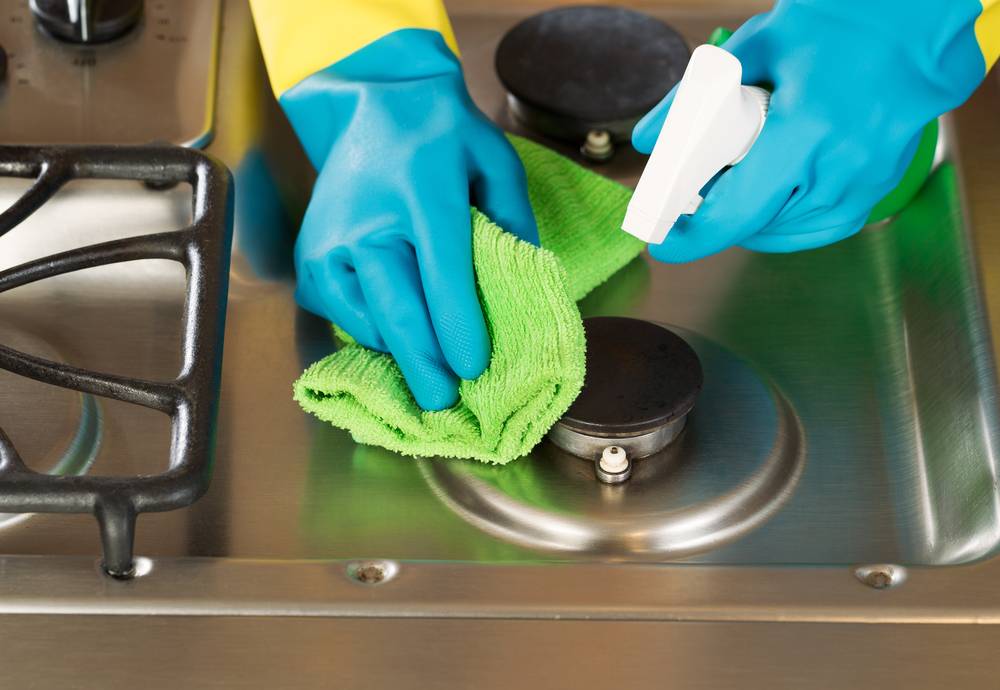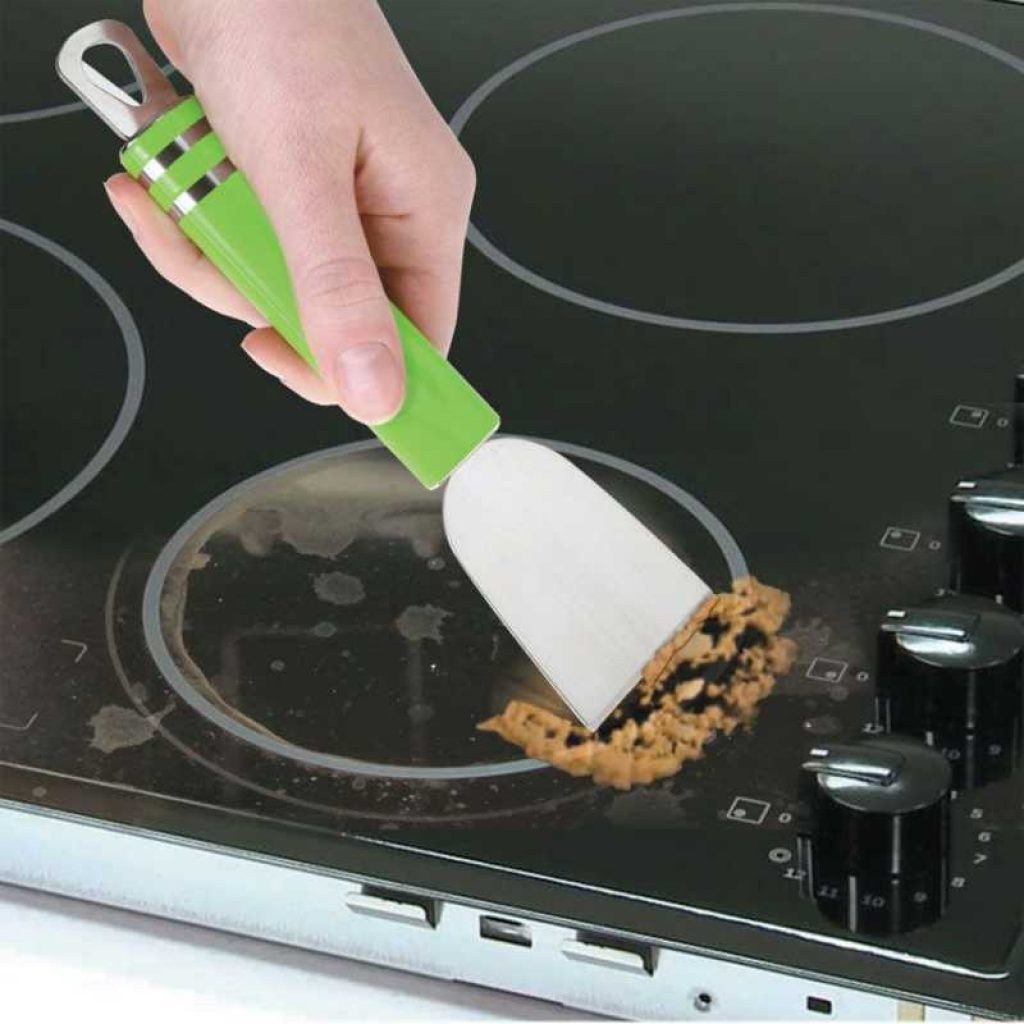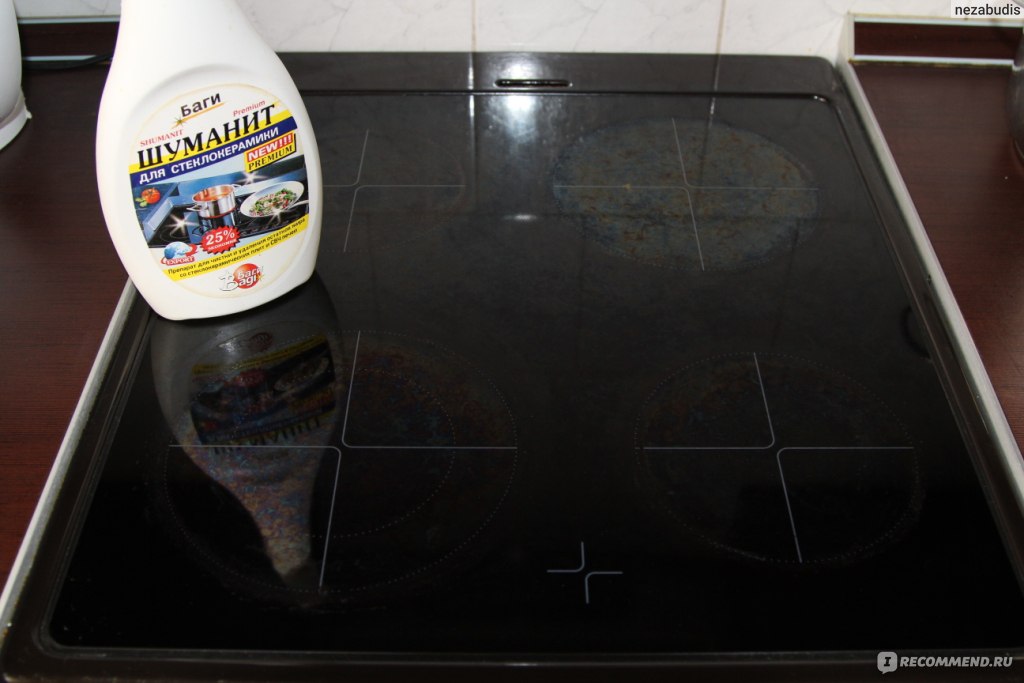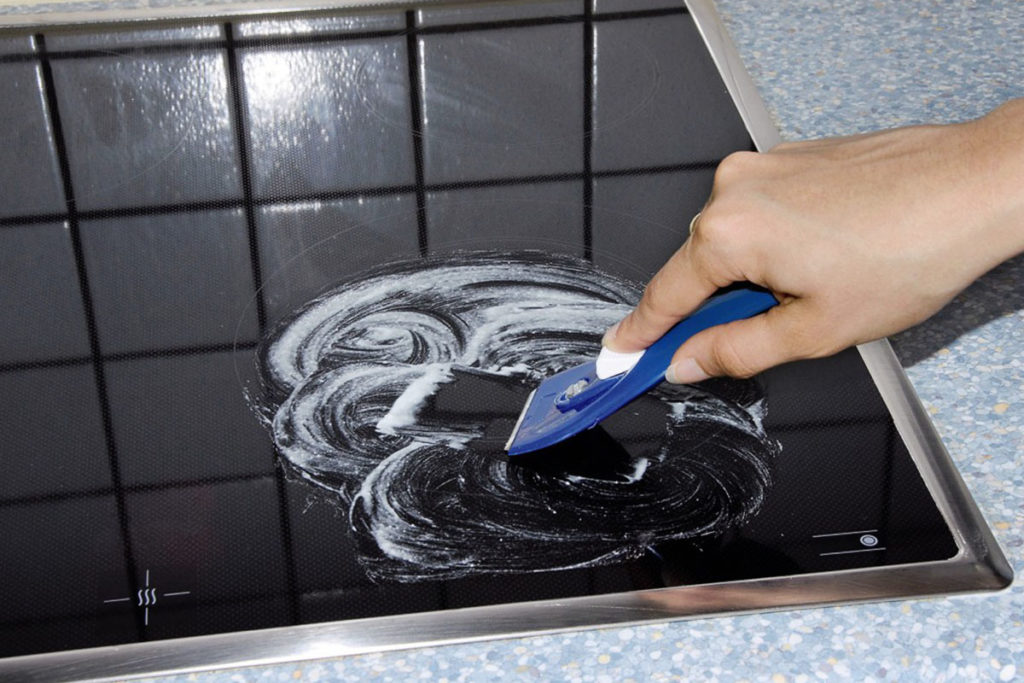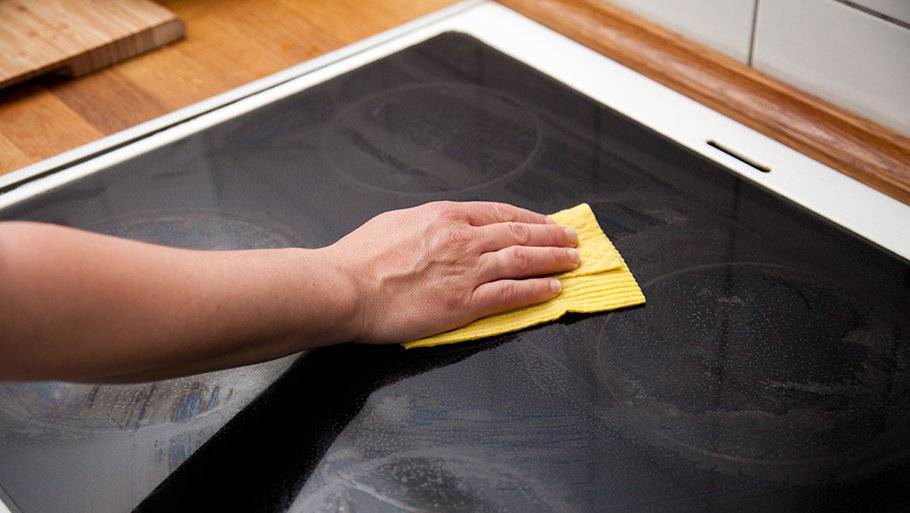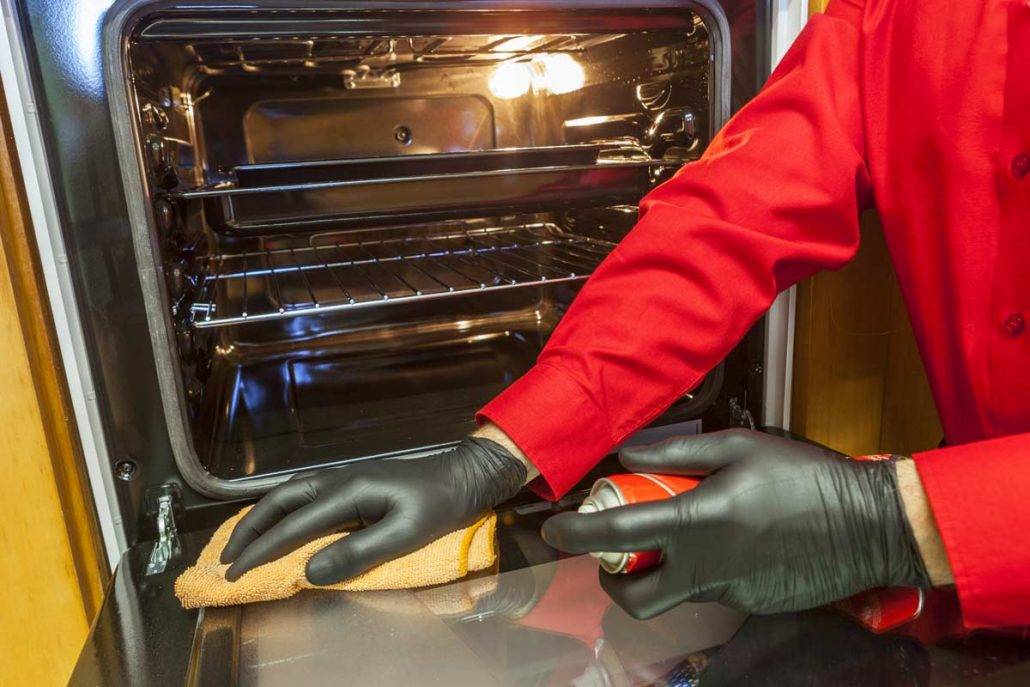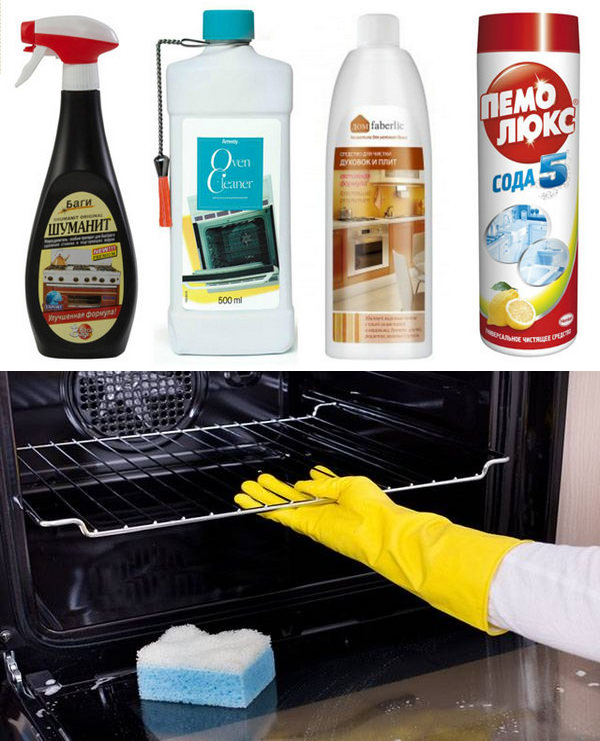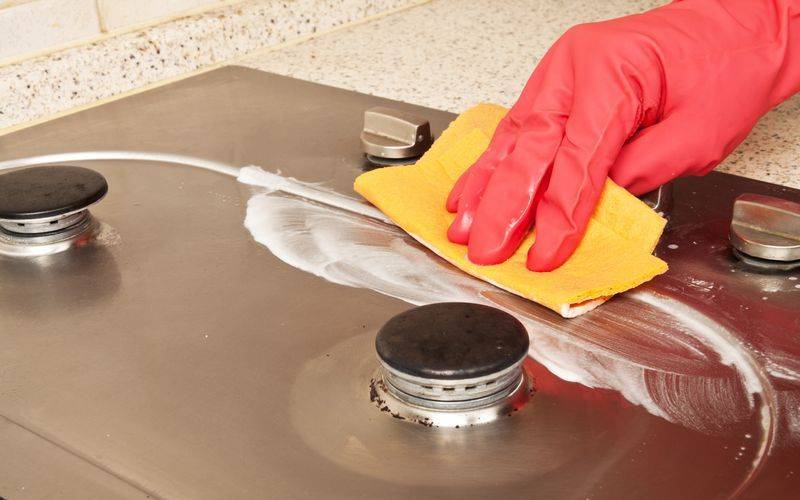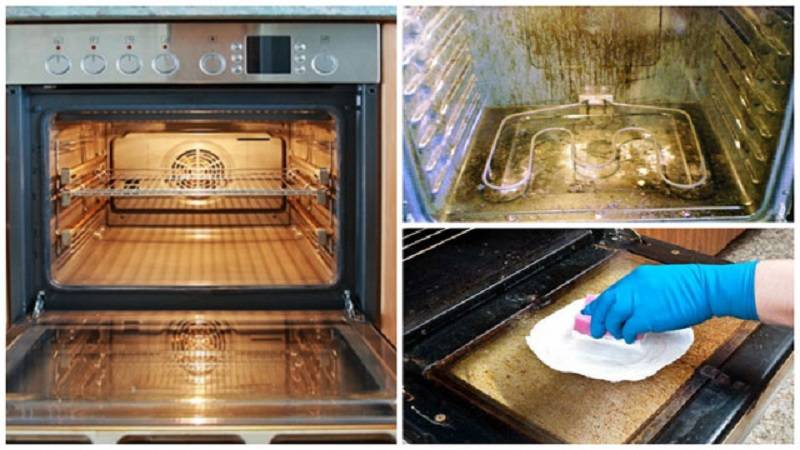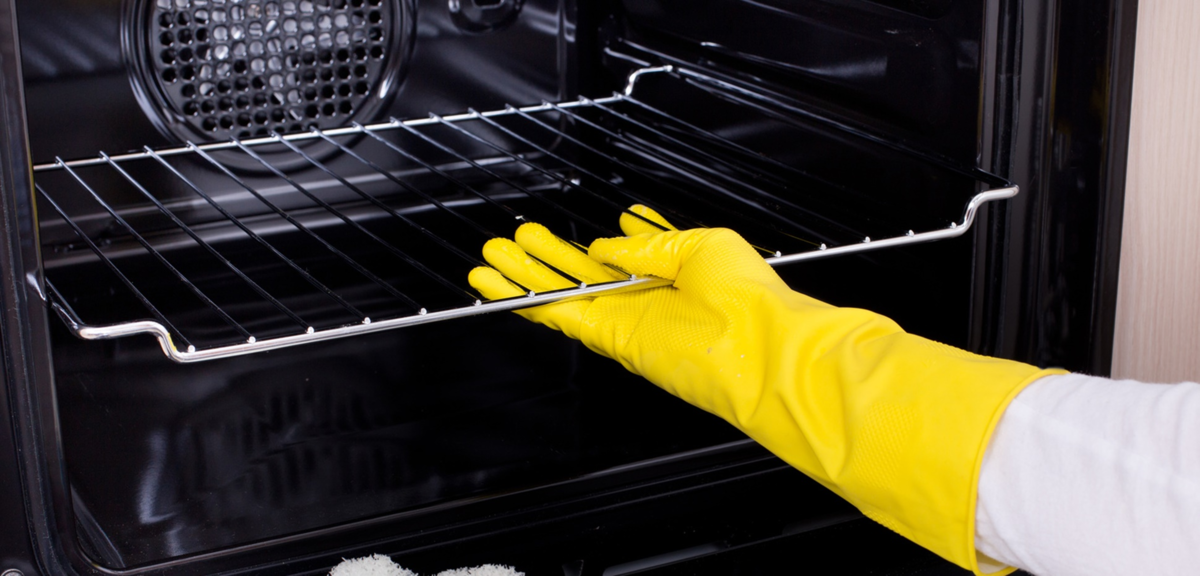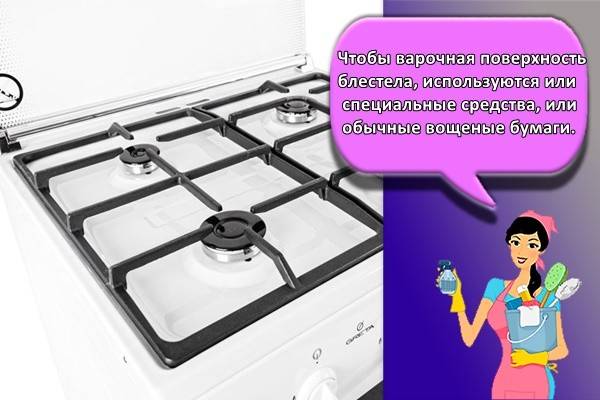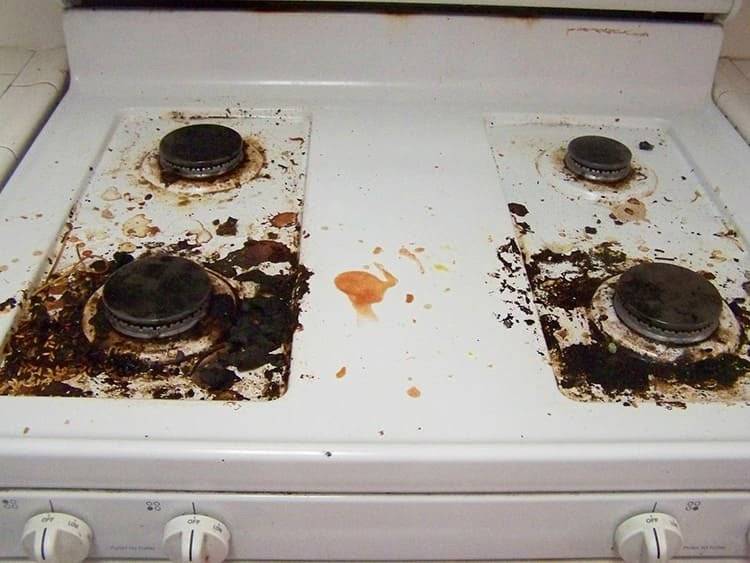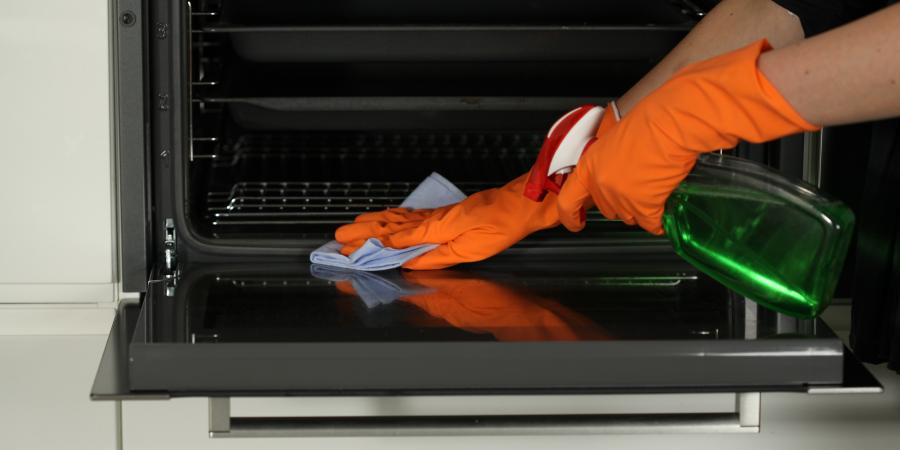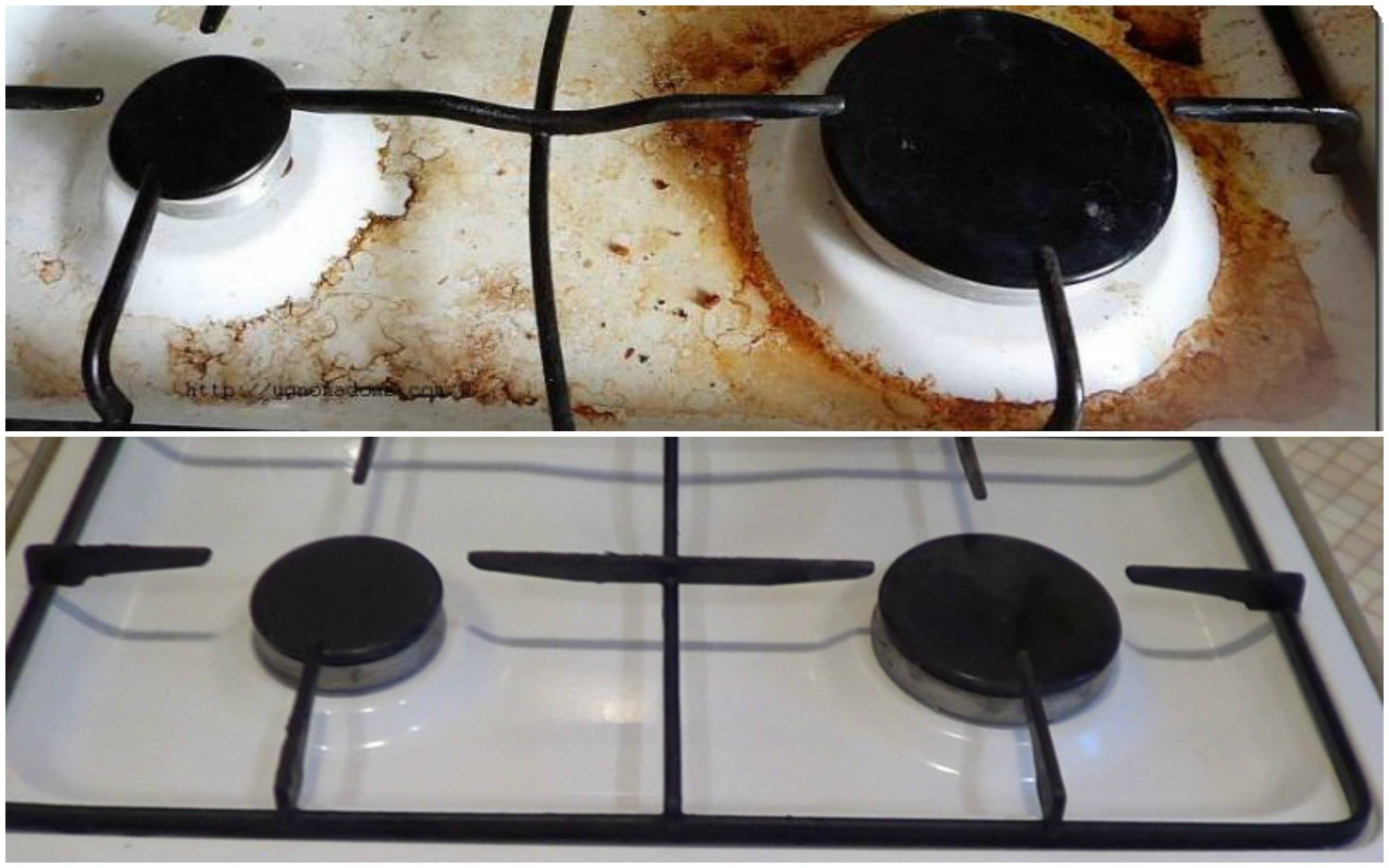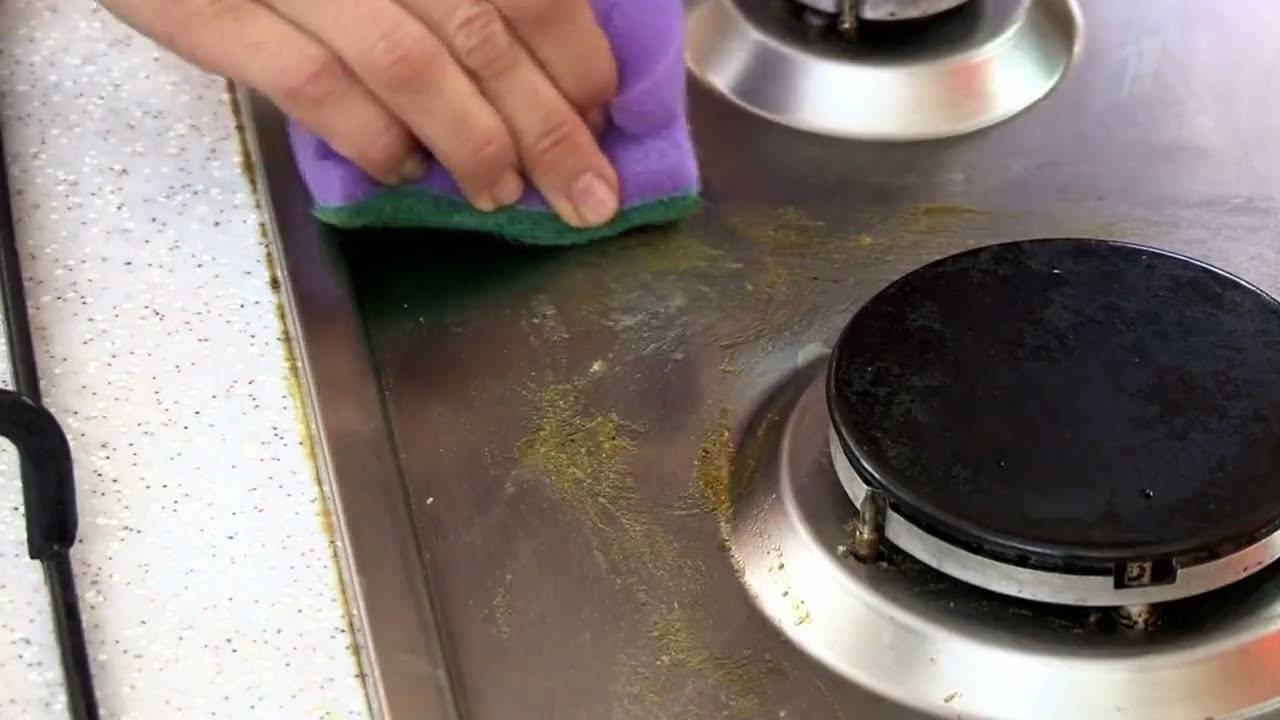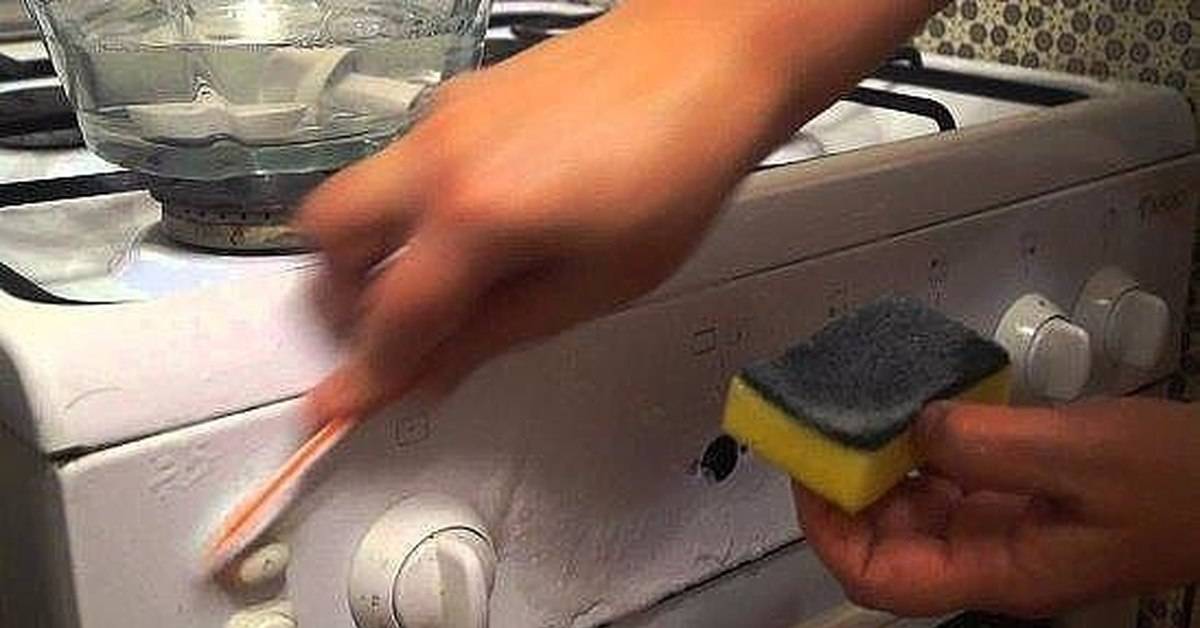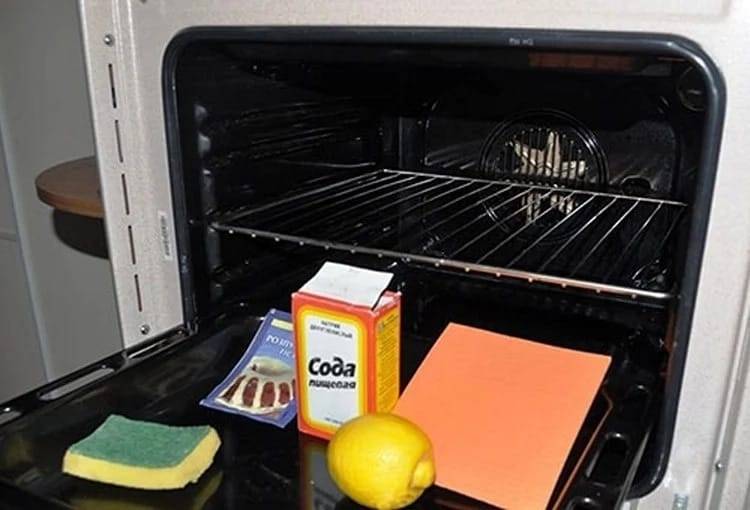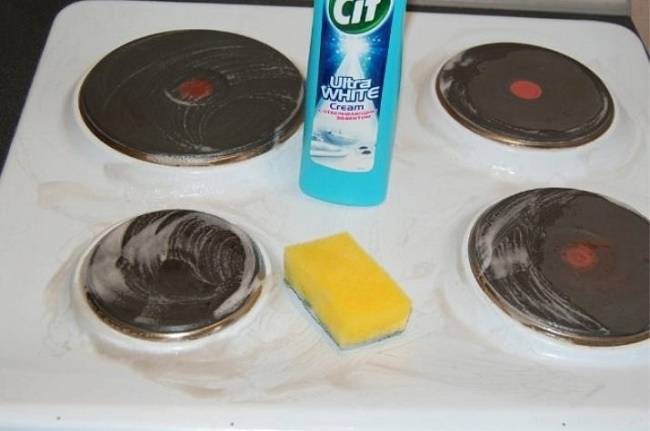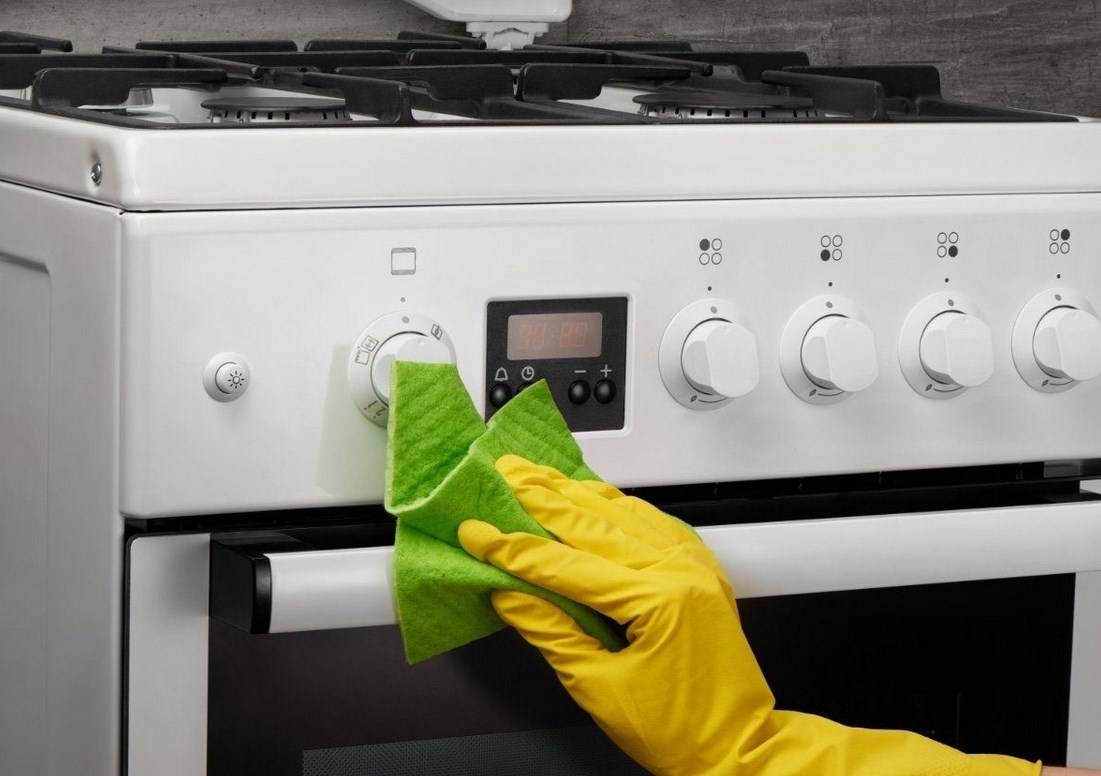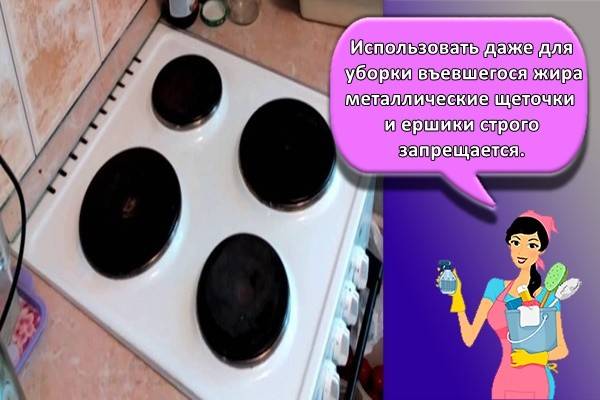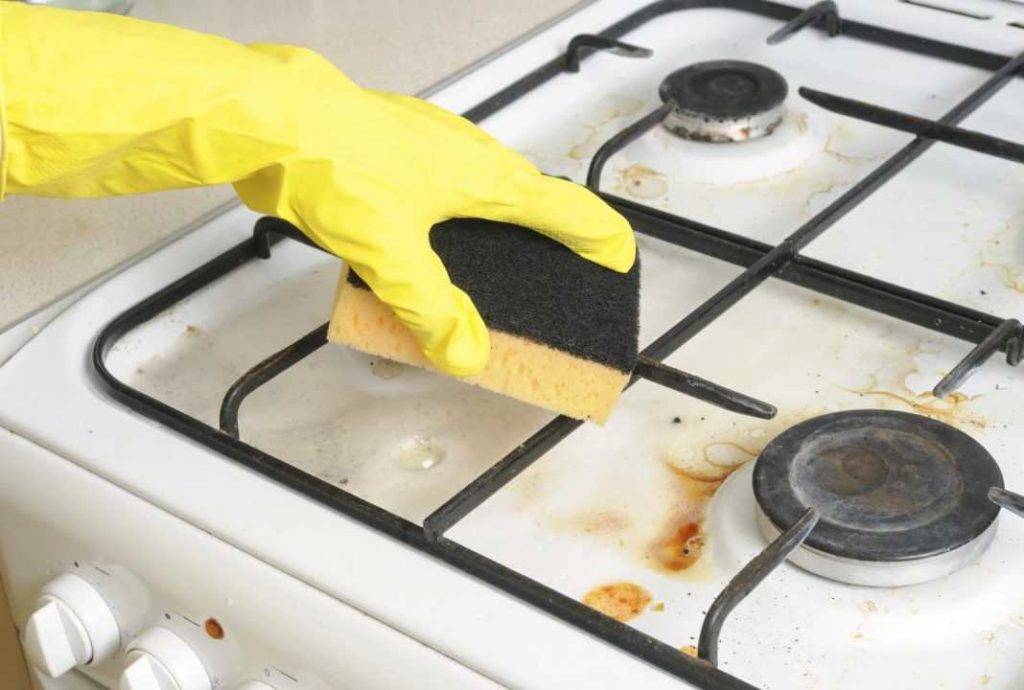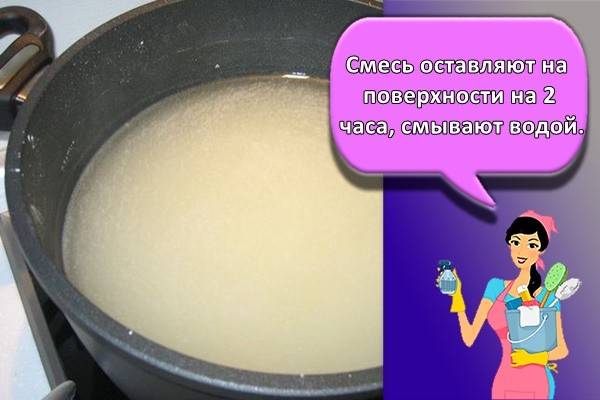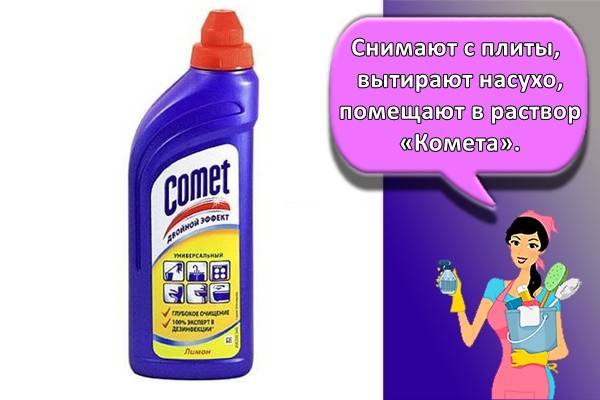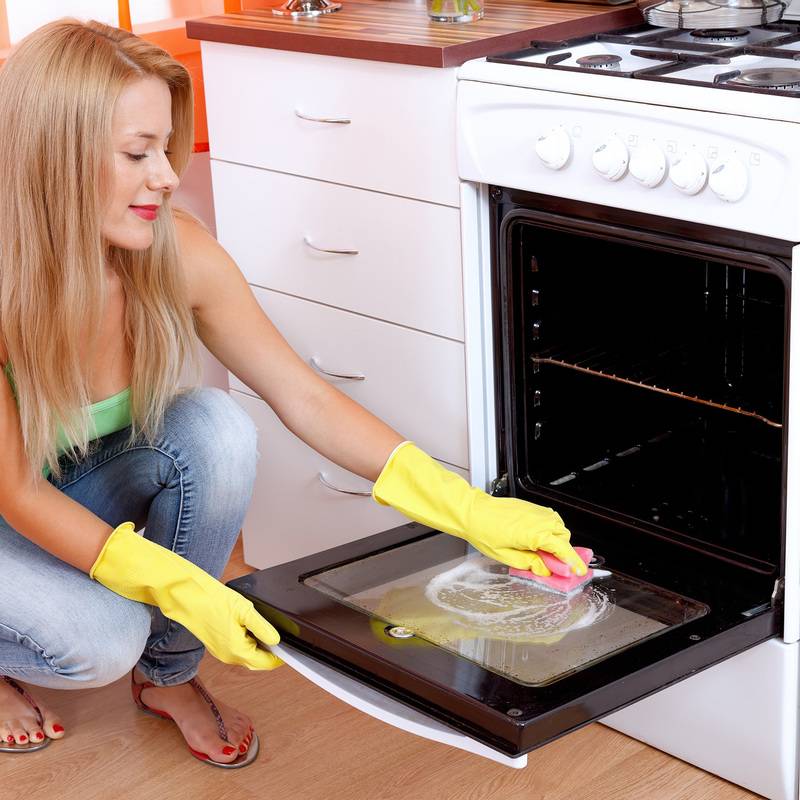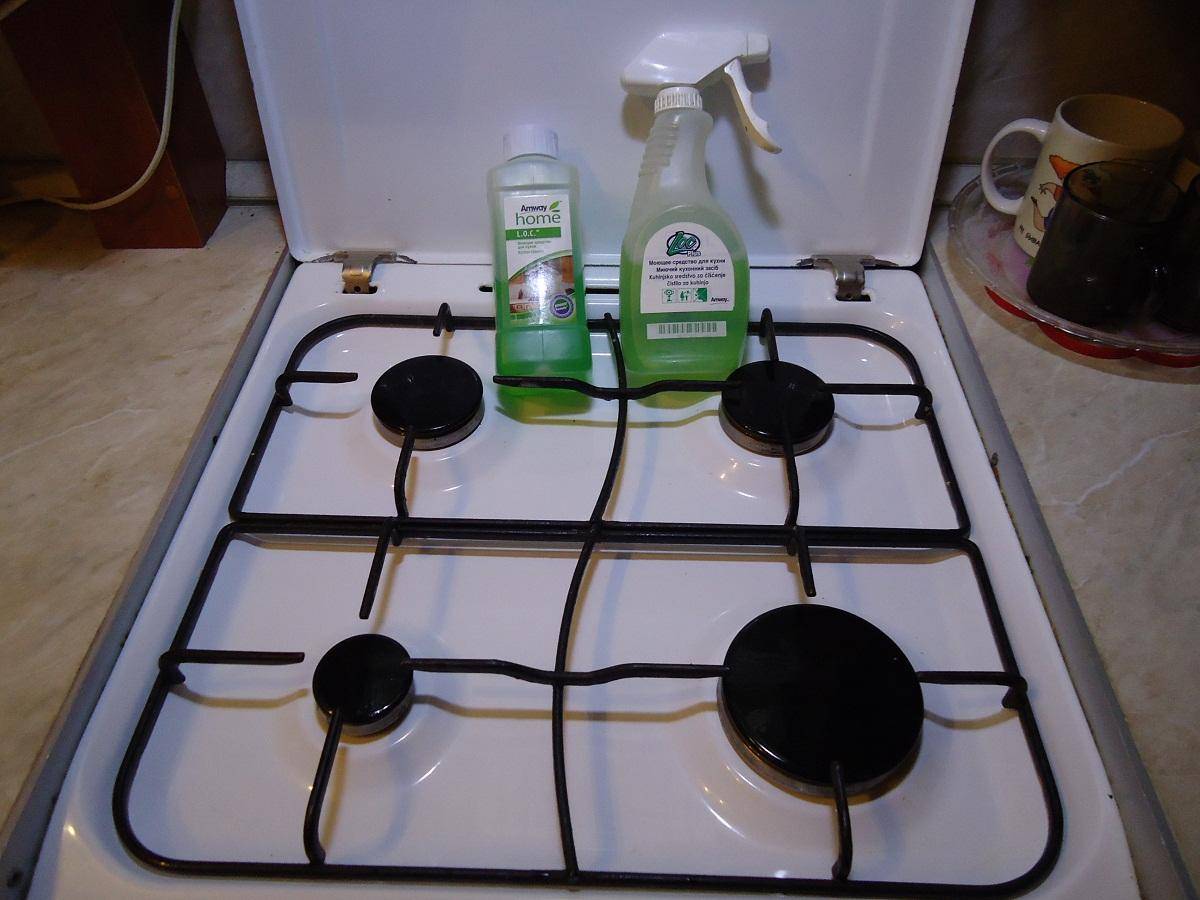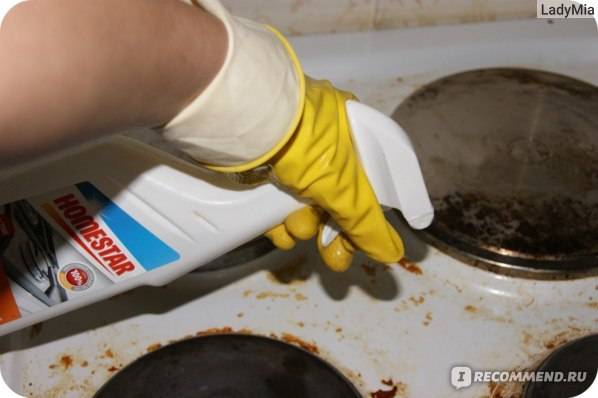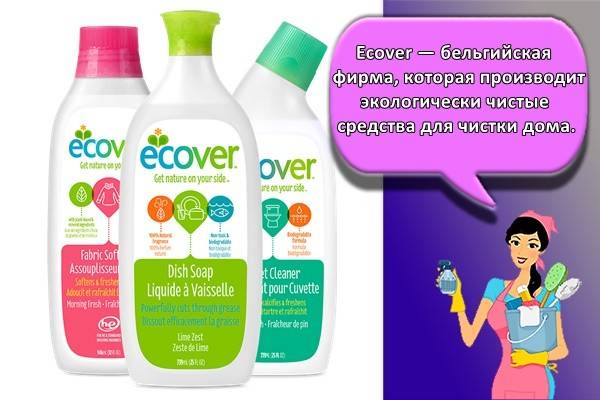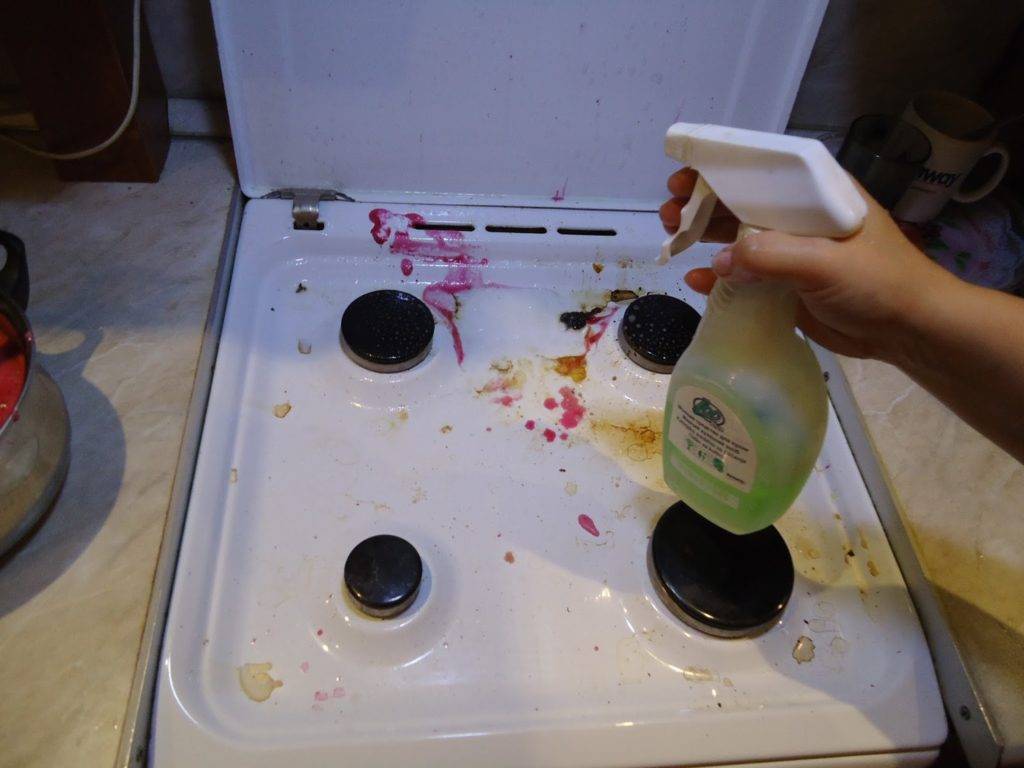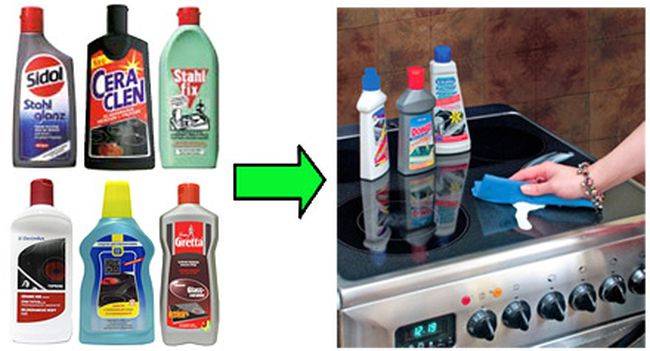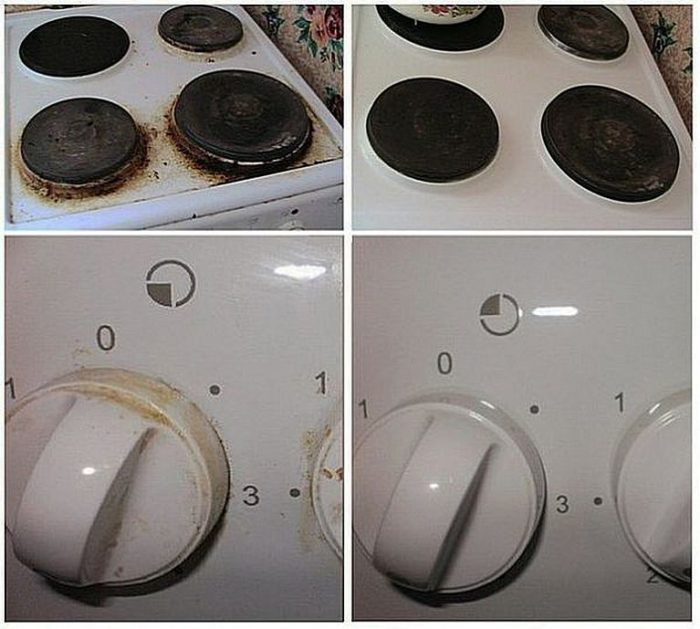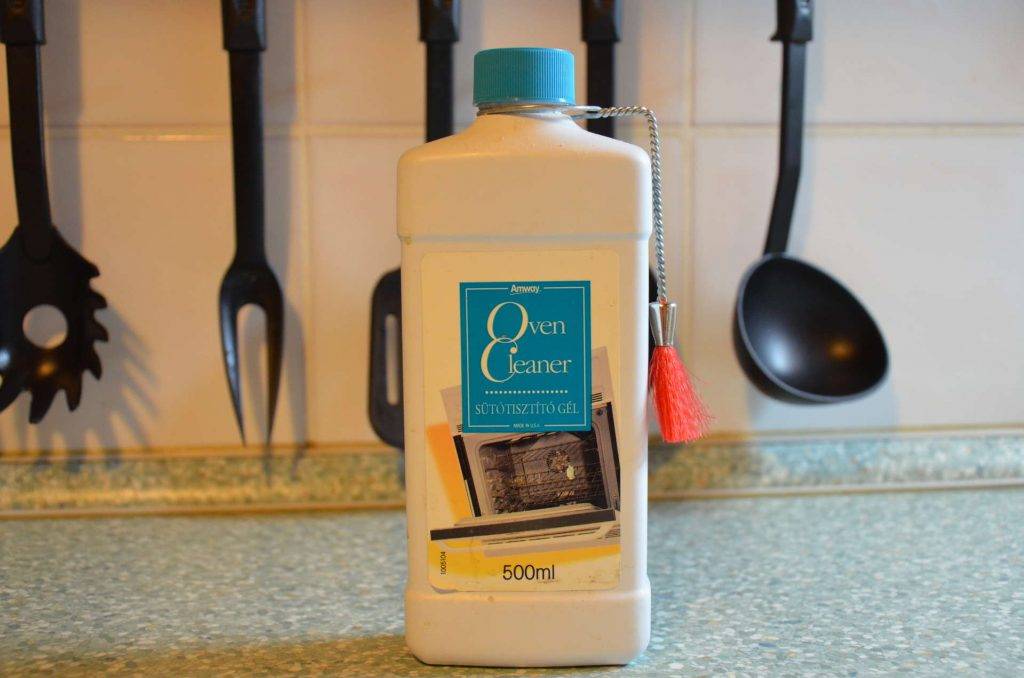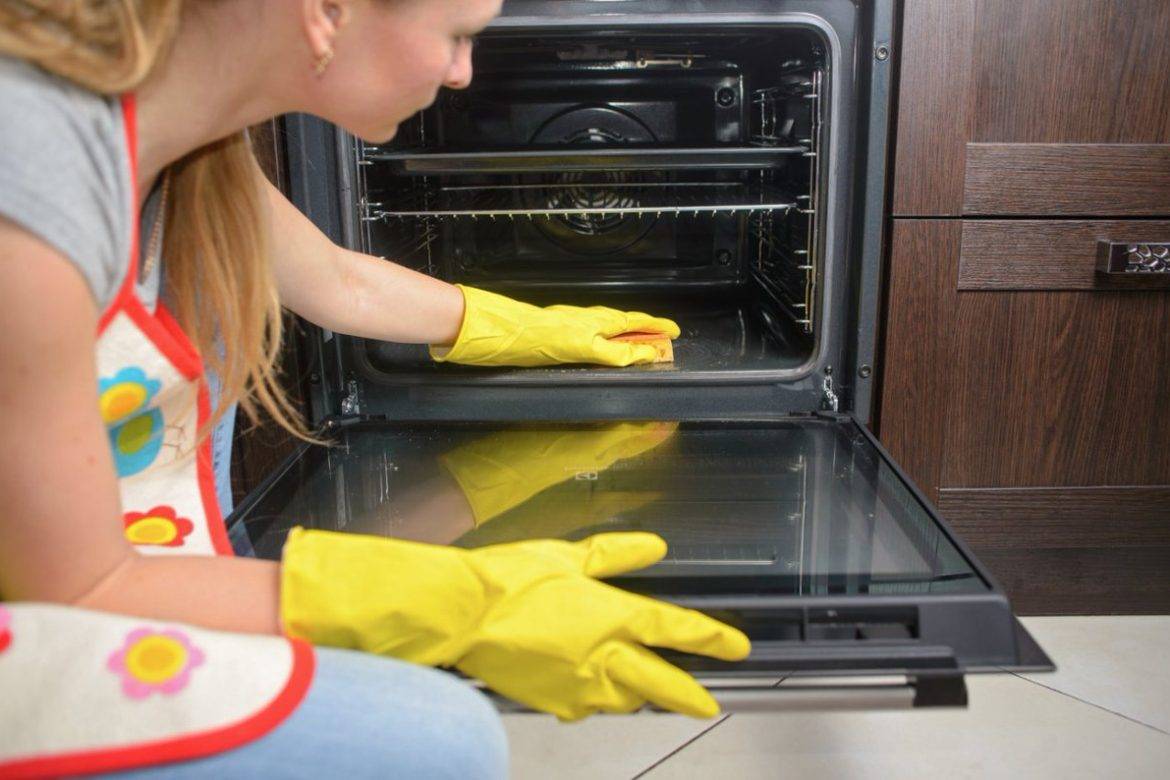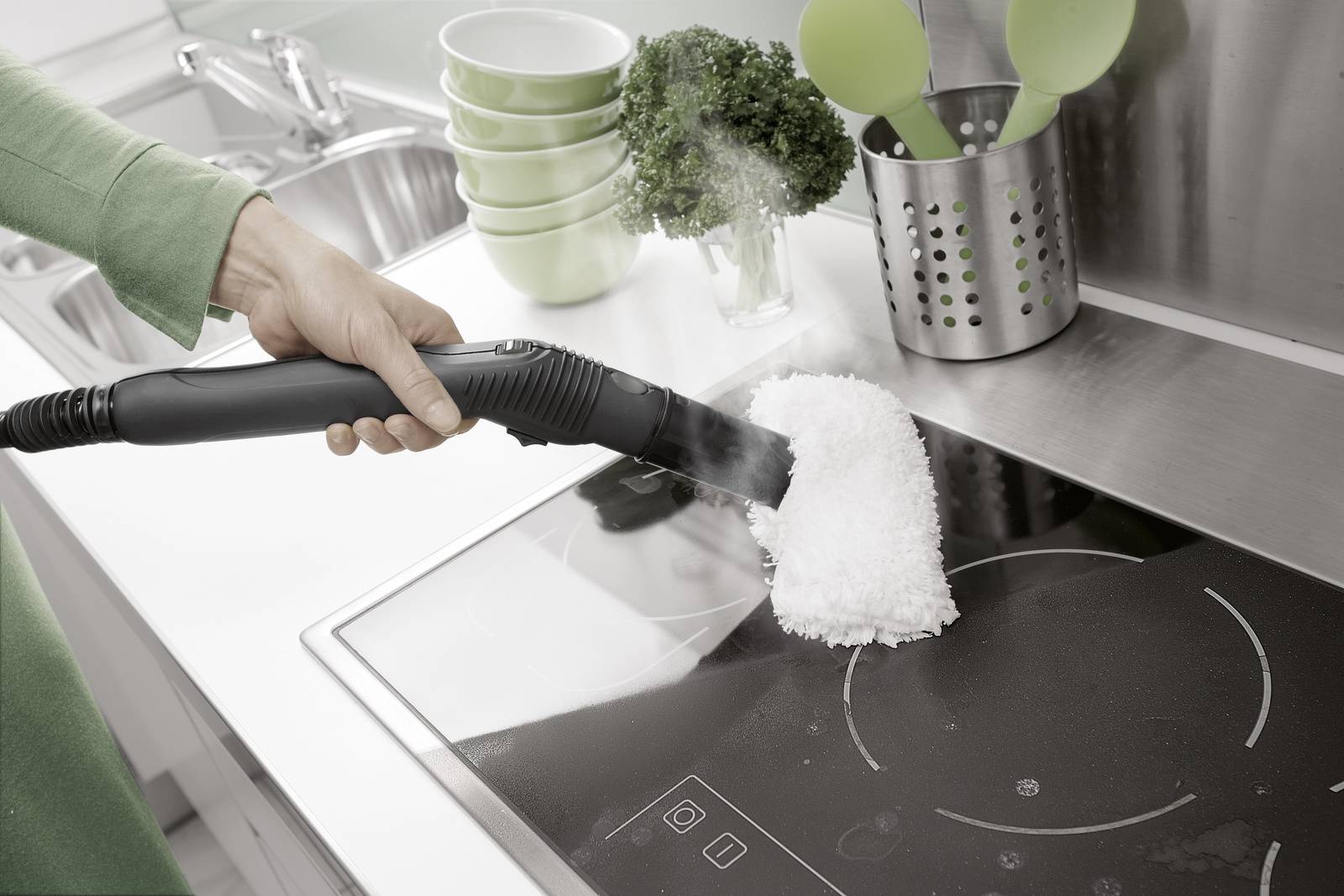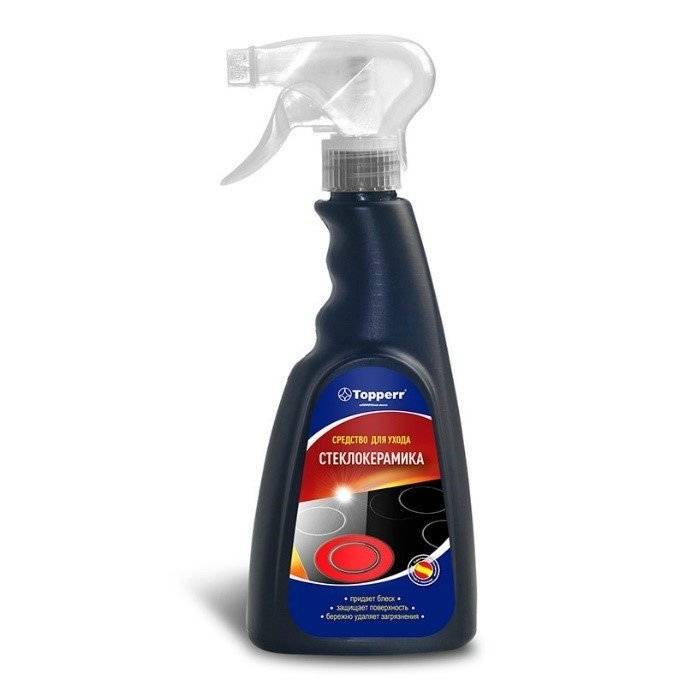Handy tools for cleaning glass-ceramic stove
You can wash the hob with the available products that every housewife has in the kitchen. Such substances are effective, but their use implies compliance with certain rules.
Lemon juice and baking soda
Baking soda can help clean up dried-on stains on your glass ceramic hob. However, the powder is abrasive, so do not apply it directly to the surface, but use it to make a cleaning paste.
Cleaning algorithm:
- In a bowl, mix baking soda and warm water until smooth.
- Apply the mixture to the burnt dirt, leave for 10-15 minutes.
- Clean the area with a kitchen sponge.
- Rinse off baking soda and dirt thoroughly to avoid white streaks.
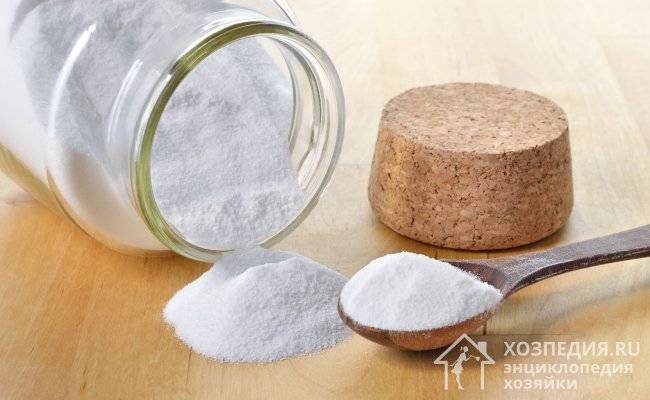 Baking soda will help clean the glass ceramic coating gently and effectively without leaving any scratches or damage.
Baking soda will help clean the glass ceramic coating gently and effectively without leaving any scratches or damage.
If after cleaning the stain remains, repeat the manipulation, but leave the soda paste for 30 minutes. After the time has passed, apply a little lemon juice to the surface. The chemical reaction between alkali and acid will break down contaminants, making them easier to remove.
Ammonia
Liquid ammonia will help to clear traces of burnt liquid, remove streaks and return the surface shine.
Application procedure:
- Pour 250 ml of distilled water and 50 ml of alcohol into a container with a spray bottle.
- Shake the bottle well to combine the components.
- Spray the product evenly onto the surface and let it sit for 8-10 minutes.
- Dry the stove with a soft towel.
Vinegar
To clean and disinfect the glass-ceramic hob, fill a spray bottle with water and table vinegar in equal proportions. Shake the container and spray the solution onto the panel. After a couple of minutes, wipe the glass with a soft cloth.
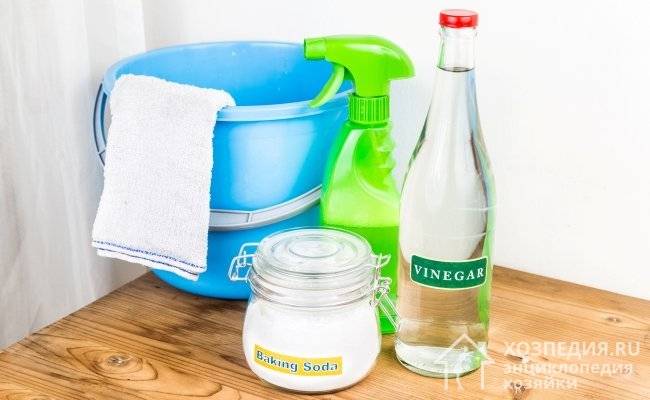 Handy tools will help to effectively clean the glass-ceramic surface from grease, carbon deposits and other contaminants. When working with formulations, strictly follow the indicated recommendations and observe the contact time of active substances with the panel
Handy tools will help to effectively clean the glass-ceramic surface from grease, carbon deposits and other contaminants. When working with formulations, strictly follow the indicated recommendations and observe the contact time of active substances with the panel
Olive oil
Olive vegetable oil will help to cope with serious pollution.
Application algorithm:
- Dip a small piece of cloth in olive oil.
- Apply the "compress" to the place of contamination for half an hour.
- Remove the softened stain with a sponge or scraper.
- Wash the surface with detergent and then wipe until shiny.
Wash off glass ceramics from carbon deposits
During cooking, various fatty deposits remain on the surface of the glass ceramic hob. The following recommendations will help you get rid of old fat and carbon deposits at home:
- Ordinary warm water will help to remove minor formation on the panel. Spray it on the contaminated area and then remove the carbon deposits with a sponge;
- In the case of an average degree of fatty deposits, a special cream or a gentle household solution is applied to the surface. After a while, it is wiped off with a rag;
- Aged carbon deposits from the glass plate are removed using a product with an alkali in the composition. It is applied to the contaminated area and after 30 minutes removed with a soft material;
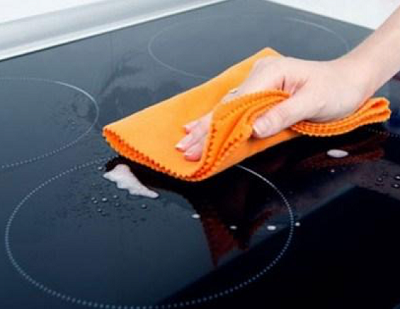 In addition, improvised household products help to remove carbon deposits from glass ceramics.
In addition, improvised household products help to remove carbon deposits from glass ceramics.
For example, vinegar is an ideal and safe option for cleaning a glass ceramic hob.
Vinegar has a disinfecting effect and removes any bacteria and microorganisms from the surface.
Making a vinegar-based cleanser involves the following steps:
- The first step is to mix equal parts vinegar and water;
- The second step is to pour the solution into a spray bottle;
- The third step is to spray in the area of contamination and wait a few minutes;
- Then wipe the stove with a dry cloth.
After these events, the stove will shine like new.
Information. Regular baking soda also helps housewives to fight carbon deposits on the stove.
Glass from burnt milk
Not only grease stains can remain on the surface of the glass plate. Often the cooker has to be cleaned of burnt milk. Regular oil will help remove organic dirt from the surface.
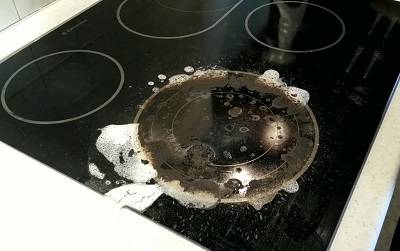 Wait until the contaminated area has cooled down before starting work.
Wait until the contaminated area has cooled down before starting work.
Otherwise, you may get burned and damage the material.
It is recommended to use olive oil for cleaning glass ceramics.
The product must be applied to a rag or a piece of cotton wool and leave on the contaminated area for 20-30 minutes.
After that, you can remove the milk stain with a sponge. The oil acts as a softener and helps to quickly remove organic stains. The slab is then polished with a window cleaner.
Important! It is worth noting that vegetable oil acts as a protective agent. A thin layer of oil is applied to the surface and rubbed
As a result, the board is covered with a protective film, which allows you to quickly remove any stains.
In the area of the burners, it is recommended to remove stains from burnt milk with a soft sponge with the addition of soapy water. In addition, a ceramic cleaner, but without abrasive particles in the composition, will help to cope with organic contamination.
How to clean the oven with lemon

There are two methods of cleaning the oven with lemon: using freshly squeezed lemon juice and powdered citric acid.
- The first method is more suitable for fresh dirt. Mix equal parts lemon juice and water. Use a sponge to scrub the walls of the oven with this solution. Let stand for 40-60 minutes and then wipe everything off with a clean, damp cloth.
- The second method copes with abundant greasy deposits and is suitable for cleaning microwaves. Fill a baking sheet or other ovenproof dish with citric acid water. For ½ liter of water, one packet of citric acid is required. Send the baking sheet to an oven preheated to 200 ° C for 30-40 minutes. Then let the oven cool slightly and wash it thoroughly. Stains that won't come off right away can be wiped off with a wedge of fresh lemon.
The effectiveness of the method is demonstrated in the following video.
How to clean the kettle from carbon deposits
Soda also helps to clear the kettle from carbon deposits. However, this substance in this case is less effective than the recipes described below.
A simple method for cleaning carbon deposits
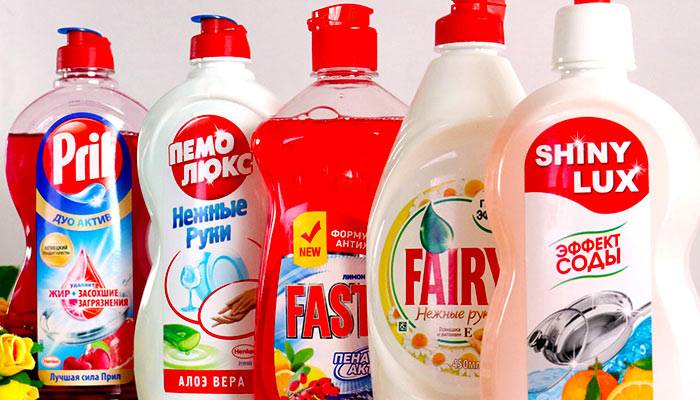
Such traces are well removed by the solution from washing powder, dishwashing detergent or laundry soap. In this composition, you need to soak a dirty kettle for at least half an hour.
After soaking the kettle, depending on the type of material, must be wiped with a sponge with hard or soft bristles.
Removing fresh traces
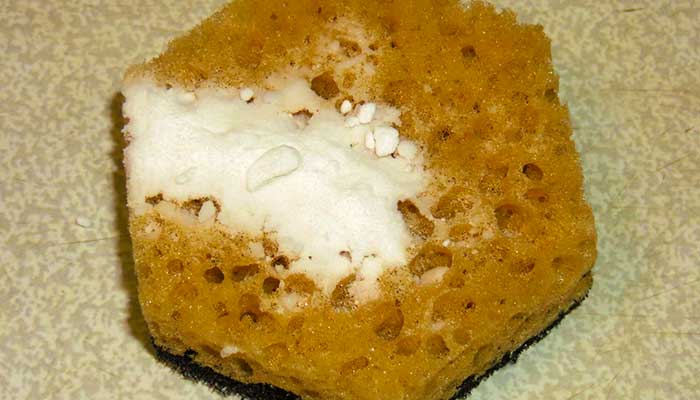
Salt is used for regular cleaning of carbon deposits. To clean up such contamination, it is enough:
- Soak a sponge in water.
- Dip a sponge in salt and rub the surface.
- Rinse the surface under running water.
In order to avoid the formation of scratches on the surface of the material, it is not recommended to intensively rub the traces of burning.
Cleaning old stains
If soot spots have appeared for a long time, you need:
- Crush several activated charcoal tablets.
- Moisten the contaminated surface with water.
- Treat traces of dirt with activated carbon powder.
After applying the activated carbon powder, wait at least 40 minutes. Then you can wipe off the burn with a damp cloth and rinse the dishes under water.
Over time, traces of grease and other contaminants appear on the surface of the kettle. When cleaning such stains, you need to take into account the type of material from which the dishes are made.A number of metals and glass do not tolerate the effects of abrasive substances that are effective against traces of grease and carbon deposits.
Cleaning sequence
Let's try to figure out how to clean a gas stove at home without extra cost and without harm. You need to choose the best product for yourself, prepared by yourself, and wash the gas stove. Determine an effective method by testing. There is no need to prepare a new composition every time. There is nothing more affordable and simpler than folk remedies for care. They are stored for several months in a cool, dark place.

The listed recipes can be modified depending on the availability of improvised means at home. To effectively clean the gas stove, you need to follow the algorithm of actions. This is the only way to achieve the desired result.
Method 2. Fast
Now let's look at a way to clean the oven from grease using steam, acid or ... ordinary dishwashing detergent. The method is suitable for cleaning a moderately soiled oven.
What you need:
- Citric acid, vinegar 70%, or conventional dishwashing detergent;
- Water;
- Deep baking sheet or large bowl;
- Rubber gloves;
- Sponge and damp cloth.
Instructions:
- Remove all unnecessary things from the oven: remove and set aside the baking sheets and everything else that is inside, but leave the grate in place - it will also benefit from a cleansing "bath".
- Turn on the oven and leave it to heat: preheat the oven to 150-200 degrees.
- Pour water into a baking sheet and dilute citric acid in it: while the oven is heating, pour water into a bowl or baking sheet and dissolve a bag of citric acid (10-20 g) in it. Citric acid can be replaced with 1-2 teaspoons of vinegar essence or a little dishwashing liquid.
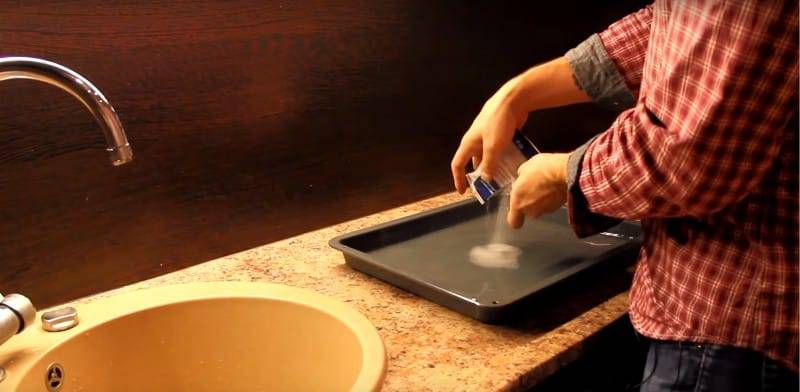
- Place the baking tray with the solution on the lower shelf of the oven: put the baking tray with the solution in the preheated oven on the lower tier. The bowl can be placed on the bottom.
- Leave the oven for 40 minutes: leave the oven for 40 minutes, that is, until the water boils and the chamber door “fogs up”.
- Turn off the oven and leave the baking sheet to cool: when the water boils, turn off the oven and let the baking sheet cool for about 30 minutes.
- Clean the oven and wire rack: when the baking sheet has cooled down, take a damp cloth and wipe down the sides of the cooking space and wire rack. Use the hard side of the sponge, spray with water, and baking soda or citric acid as needed to remove stubborn grease and carbon deposits.
- Put the trays and wire rack back in place: Woo-ala! The oven shines again and inspires culinary feats.
General rules for cleaning at home
Regardless of what kind of cleaning agent is chosen - with chemical components or environmentally friendly - you need to adhere to certain rules when cleaning. Slabs can be enameled, glass, ceramic or metal and all require proper care. The grates, handles are cleaned separately, they must be soaked for 15-20 minutes. If this is not done, then the dirt will be poorly cleaned, and the hostess will spend much more effort and time on this.
Surfaces
The surface of the stove determines which detergent to choose. Cannot be used for electrical applications with large abrasive components - they will scratch the surface. It is better to stay on sprays, gels, and not buy powder products.
Metal
Metal surfaces themselves are quite resistant, hardly susceptible to impacts and the appearance of chips. But they become ugly over time if you clean them with metal brushes and sponges. The washing procedure looks like this:
- wait until the heating zones have completely cooled down;
- turn off the stove;
- gently apply a layer of the product to the most contaminated areas;
- wait 15 minutes;
- wipe with a damp cloth until completely clean;
- treat with napkins and clean water to remove the product.
To make the hob shine, either special products or ordinary waxed papers are used.
Enamel
The enamelled surface must not be washed with aggressive powder detergents and hard brushes. If it is damaged, then harmful substances can get into food and cause poisoning. A special plastic scraper is used. A composition is selected that will create a film.
Glass
Glass materials are beautiful, but they require careful maintenance. Cleaning begins only after complete cooling. To remove frozen particles, a damp cloth soaked in solution is applied to them. Creams and gels are suitable, in which the granules play the role of an abrasive. At the end it is treated with a spray to create shine.
Ceramics
Ceramic materials are easy to clean, but grease adheres quickly and strongly. It is recommended to use foams and pastes that do not drain, but act directly on the source of pollution.
Lattice
The grilles are made of cast iron or stainless steel, which hardly tolerate high temperatures. The cleaning procedure is slightly different.
Cast iron
Cast iron strongly absorbs grease and carbon deposits and is difficult to remove. The gratings are treated with strong substances, you can use abrasive ones, since the strong material will not be damaged from them.
Stainless steel
If the grill is made of stainless steel, it can be placed in the dishwasher. Before that, soak in warm soapy water. It is preferable to use a silicone scraper.
The handles are made of plastic, which suffers greatly from fat hardening. The pens are removed and placed in a solution of soapy water for 15-20 minutes. Particles are removed with scrapers, ribbed faucets, common on older stove models, are cleaned with toothpicks.
How to clean the handles and grate properly?
Knobs, switches and other small items are easiest to clean if you remove them first. We soak the parts in soapy water, rinse with a sponge or toothbrush, removing dirt from hard-to-reach places. If necessary, we use soft natural abrasives, for example, soda. At the end, we rinse and dry all the products.
If time does not allow for such a laborious event, at home you can do with surface treatment. To do this, we take a remedy proven over the years - anise drops with ammonia alcohol. If you approach the problem correctly, then it will be possible to wash fresh and old dirt from all small parts without any problems. We moisten a cotton pad in the composition, distribute the product over the working surface, wait five minutes and wipe everything with a clean damp cloth.

If there is a lattice plate on the model, you need to take care of its processing. In the case of a cast iron product, we act according to the following plan:
- We calcine the material over a fire so that the remnants of dry dirt fall off on its own.
- We apply a caustic agent to the surface of the product, leave it overnight.
- Then we treat the element with a composition for cleaning engines, wash off its remnants and dry it.
When working with a steel product at home, proceed as follows:
- Soak the grate in warm water with the addition of soda and vinegar for several hours, or overnight. In the morning you need to wash off the dirt, rinse the product with water, do not dry it.
- On a still wet object, apply a thin layer of mustard powder, leave for half an hour. Then we rinse and dry everything.
- If it was not possible to completely remove the dirt, then spread it with soda paste and rinse in clean water after 40 minutes.
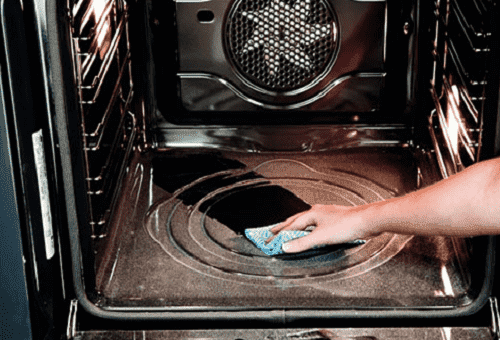
Applying these recommendations, you do not have to worry about the preservation of the texture of the material and the appearance of the slab. But it must be remembered that the earlier the treatment is carried out, the greater the chances of its positive outcome.
How to clean with special products
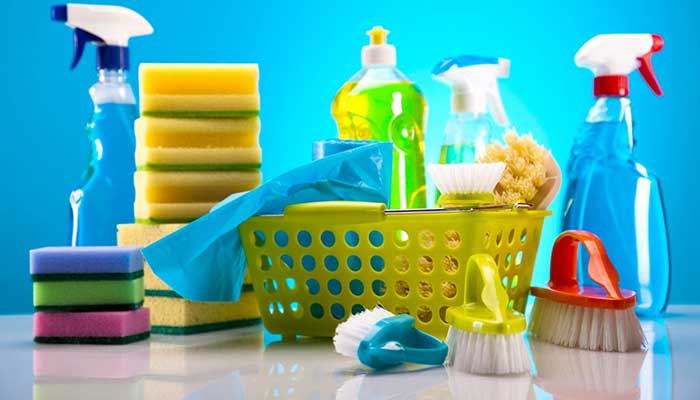
When using household chemicals and professional cleaning agents, special attention must be paid to safety measures. Household chemicals can only be used on a completely cooled surface.
Ventilate the area well, wear a mask and gloves, and keep children and animals out of the kitchen.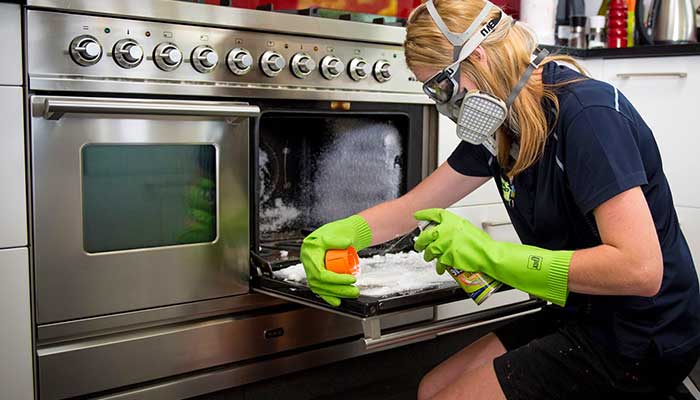
Food must be put in the refrigerator or cabinet.
Professional drugs work quickly and efficiently. After applying them to the surface, the decomposition of fatty deposits and proteins begins. Then it remains only to wash off the chemistry from the surface. Some products contain silicone, which forms a thin protective layer that allows you to stay clean for longer.
Next, let's take a look at the most famous brands of oven cleaners.
Budget Bagi Shumanit

Production - Israel. Price - from 150 rubles. The agent is applied to the surface for 2-10 minutes (depending on the severity of the contamination). After brown stains appear, the preparation can be washed off with warm water. Differs in a pungent odor. It is consumed sparingly. Perfectly copes with old dirt on metal, enamel and cast iron surfaces. Poorly cleans ceramics and may damage aluminum and Teflon products.
Frosch Mild Cleanser

Production - Germany. Price - from 250 rubles. Environmentally friendly household chemicals. The product is sprayed onto the surface for a few minutes and removed with a damp cloth. Has a pleasant smell and can be used without gloves. Can be used in food contact areas. Suitable for cleaning ovens, grills, glass ceramics. It removes grease well, but does not deal well with old stains.
Eco-Friendly Synergetic

Production - Russia. Price - from 150 rubles. Refers to eco-products. The drug is sprayed onto the surface, kept for 3-5 minutes, then washed off with water. Suitable for ceramics and glass, but not aluminum. When using on Teflon and enamel surfaces, be careful not to exceed the manufacturer's recommended holding time.
Super Amway Oven Cleaner
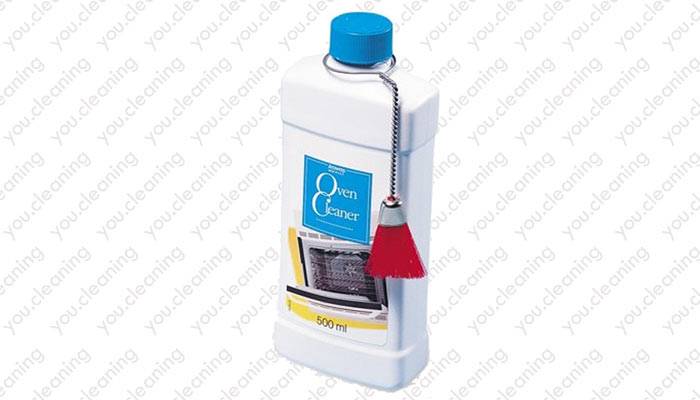
Production - Belgium. Price - from 500 rubles. The drug is applied to the surface with a special brush, kept for 30 minutes and washed off. Very strong product, so avoid contact with skin, clothing and any surfaces not intended for processing. Suitable only for enamelled and stainless surfaces. Not suitable for aluminum, painted and chrome plated.
How to clean a gas stove from fat and carbon deposits with folk remedies
When removing dirt from the hob, you must carefully select the means and methods of cleaning. Stylish stainless steel plates require a special approach. Since their mirror or matte surface easily loses its shine and attractive appearance with micro-scratches.
Ingredients for preparing cleaning compositions can be:
- soap;
- vinegar;
- mustard powder;
- soap-based product;
- lemon or citric acid;
- ammonia-anise drops;
- soda;
- detergent powder with a low degree of foaming;
- silicate glue;
- ammonia;
- salt composition;
- dishwashing liquid;
- soap and soda solution.
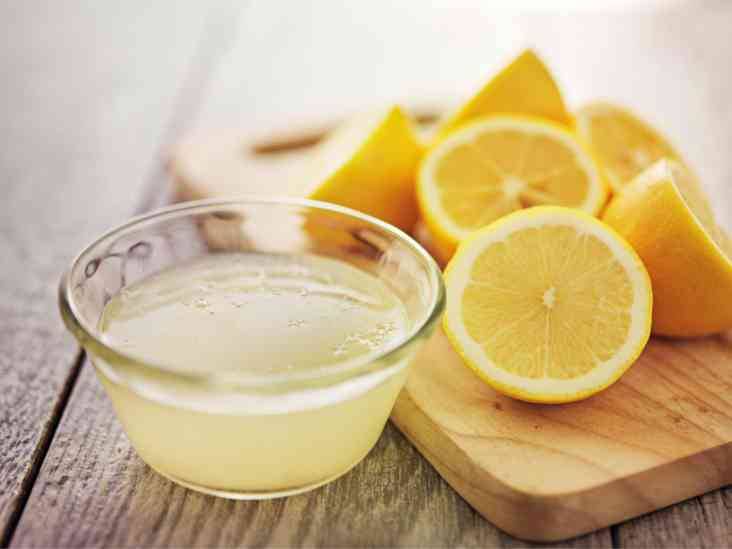
How to wash a stainless steel plate? There is a difference? Yes, you cannot use all the listed components indiscriminately. Eliminate strong acids and alkalis that can cause stains.
Lattice
The largest deposit of carbon deposits forms on the grate. Food burns instantly, forming a persistent coating. It is difficult to wash this element of the slab due to its geometry. Therefore, trickery is indispensable here.
- The best way is to put the grates in hot soapy water and laundry soap for 2-4 hours. The acidified dirt can be easily washed off with a cloth without the use of force and additional tools.
- A good folk remedy is to apply a sponge of pure ammonia to the wire rack and then wrap it in a plastic bag for a couple of hours. Carbon deposits will fall off in pieces or peel off with a film.
- To clean the gas stove, a soap-soda and soap-powder solution is also used. The main condition is to place the grates in a hot mixture.
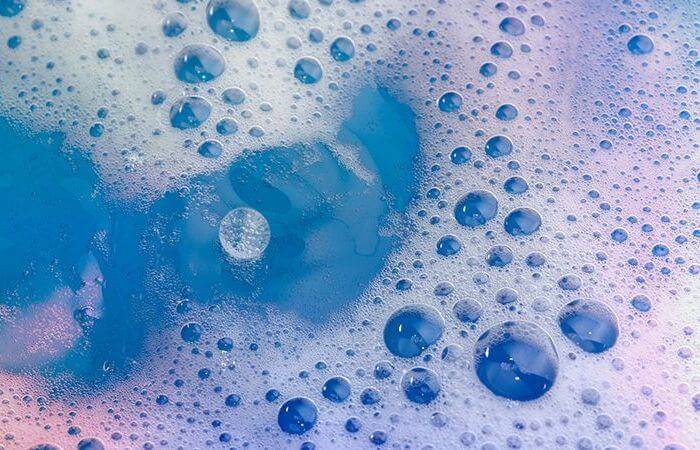
Burners
To quickly and efficiently clean the gas stove and burners, which have complex geometries, where recesses and holes are often clogged with burnt fat, you need to additionally arm yourself with a needle, wire, toothpick, paper clip and toothbrush. At least one of the listed items is sure to be found at home.
Taking care of stainless steel burners at home is quite problematic. They need to be removed, checked for carbon deposits inside the structure. They can be cleaned with high quality with your own hands using a soapy solution. You need to immerse them in water along with the grates. For cleaned burners, be sure to check and clean all holes with a thin needle and a straightened paper clip.
Pens
Gas stove handles are just as greasy as other places. Wet, often greasy, housewives' hands leave dirt in the recesses of the switches. But how to clean pens in hard-to-reach places, not every skilled worker knows.

Cleaning the handles of a kitchen assistant is problematic, especially if they cannot be removed. In this case, you need to apply baking soda, a paste of soda ash and soap to the handles and the panel and wipe all these components of the plate from grease. To wash the removable handles, you can boil them in vinegar solution for 5 minutes. After cooling, wash with a washcloth. Use an old toothbrush in hard-to-reach places.
Removing grease stains from the surface
It is less difficult to remove grease from a gas stove with a stainless surface than burnt food, which penetrates deep into the paint layer. You can use any detergent and washcloth to remove fresh grease from stainless steel. Apply the product to a sponge, lather and distribute over the hob. When using active chemicals for care, do not use a sponge used for subsequent dishwashing.

Care and maintenance tips
Recommendations for the use and daily care of an electric or gas ceramic glass hob:
- before turning on the device, check that there are no food or liquid residues on the surface, otherwise they will burn, making removal difficult;
- wipe the surface with a damp cloth after each use;
- clean the stove after it has completely cooled down, since the coating may crack from the temperature drop;
- do not use abrasive substances or metal sponges - the scratches left will make it difficult to maintain the surface, which will quickly render it unusable;
- do not place plastic, copper and aluminum containers on the stove, avoid punctual impacts on the coating;
- after washing the surface, wipe it dry so that no streaks remain.
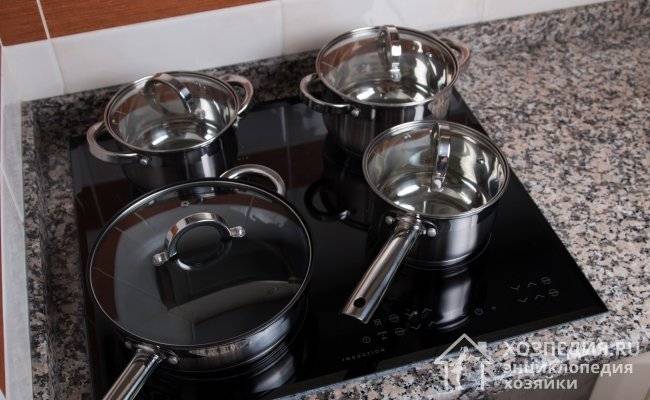 Place only dry and clean dishes with a flat bottom on glass-ceramics without damage.
Place only dry and clean dishes with a flat bottom on glass-ceramics without damage.
When purchasing a glass ceramic hob, be prepared to provide it with proper care. To maintain normal operation, follow the operating procedures, carry out daily cleaning and remove significant contaminants in a timely manner. By following simple guidelines, you will retain the functionality and presentation of the panel for years to come.
How to eliminate the smell of detergents in the oven
The problem with modern detergents is that they have very persistent odors. After some, it is impossible to cook in the oven for at least a couple of days - otherwise the food also acquires the aroma of chemistry.
 A clean oven without unnecessary odors is quite real.
A clean oven without unnecessary odors is quite real.
However, this can be combated. The easiest but longest way is to air it. Do not close the oven until the aroma has completely disappeared.
In addition, you can wipe the surface with lemon juice - it will bind excess aroma and quickly remove it.
An effective method of urgent odor removal is activated carbon. Dissolve the pack in a small saucepan of water, and then boil for 10-15 minutes. The problem is guaranteed to be solved.
Another method that interests us is to rub the inside of the oven with raw onions. The author then suggests leaving it open for a few days until the onion smell wears off. Basically, onions are guaranteed to kill detergent residues. But the meaning of such a procedure is not very clear - all the same, you will not be able to use the oven for two or three days, and not everyone likes onions. But if you want, you can experiment.
We hope these tips will help you keep your oven clean.
The main stages of washing a stainless steel plate
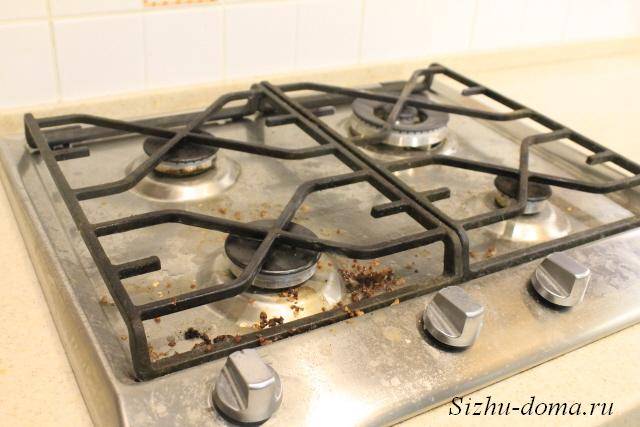
I will make a small reservation. The idea of writing an article on how to wash a stainless steel stove came to me after returning home from a multi-day business trip, during which my younger generation and her husband not only warmed up lunches and dinners prepared for future use, but also cooked dumplings and even buckwheat porridge.
Actually, buckwheat porridge, which has completely dried to the stove, caused my family the greatest difficulties when washing the stove. And she waited for me ...
Remove the grate from the stove
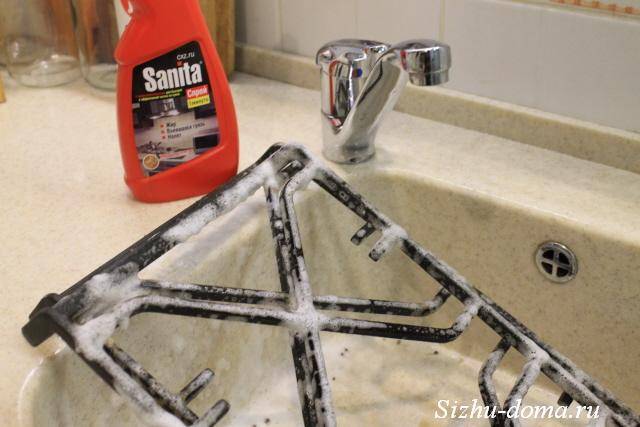
To speed up the washing process, you can apply any dishwashing detergent or kitchen detergent on the wire rack. As a rule, the grate for gas stoves is made of a very dense and wear-resistant material (mainly cast iron), so the grate can be washed with any abrasive agent.
While our grate is "soaking", let's get down to the stove.
We treat the stove with detergent
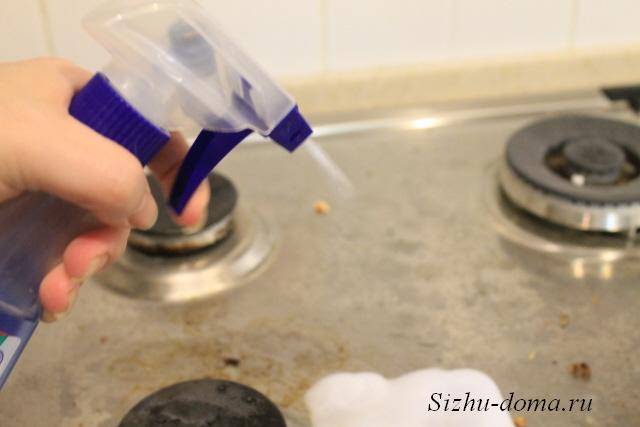
Under no circumstances should you rub the surface!
Scraping off burnt or dried food from the stainless steel stove can damage the surface, leaving unsightly scratches on it.
It is best to cover the entire surface of the stove with detergent and leave it on for a few minutes.

It is necessary to wash the grate from the stove both from the top, the surface on which food is prepared, and from the bottom - there are also pieces of burnt food left there.
For speed and convenience, you can take a dishwashing sponge, apply a cleaning agent on an abrasive (harder) surface, wrap the sponge around individual sections of the grate, and thoroughly rinse all parts of the grate with rubbing movements. Then the grill is rinsed and wiped with a soft cloth.
My stove
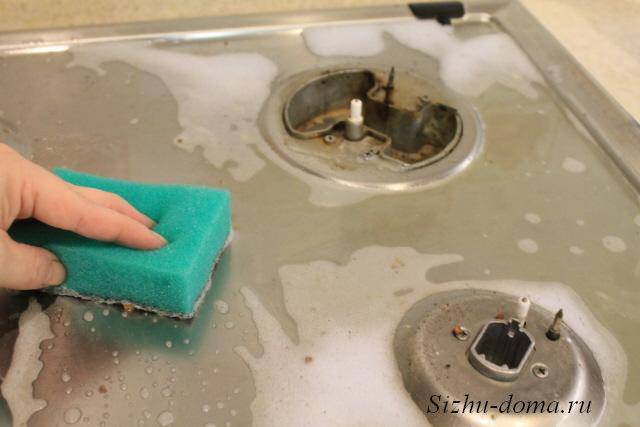
If the stove is in a very neglected state, and food remains are hardly removed from the stove surface, you can spray a little more detergent, focusing on the most difficult areas, and wait a little longer.
After that, remove the remaining food and foam with a sponge, rinse the sponge, and wipe it again until the stove is clean.
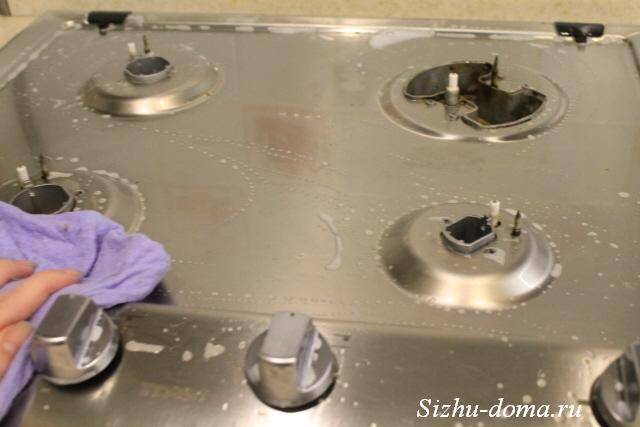
At this stage, the cloth must be rinsed several times, completely removing the remaining detergent.
Thorough rinsing of the cloth during washing prevents possible stains on the stove.
Wipe dry, collect
We wipe our stainless steel plate with a soft dry cloth, or a kitchen towel, - “rub” it until it shines.
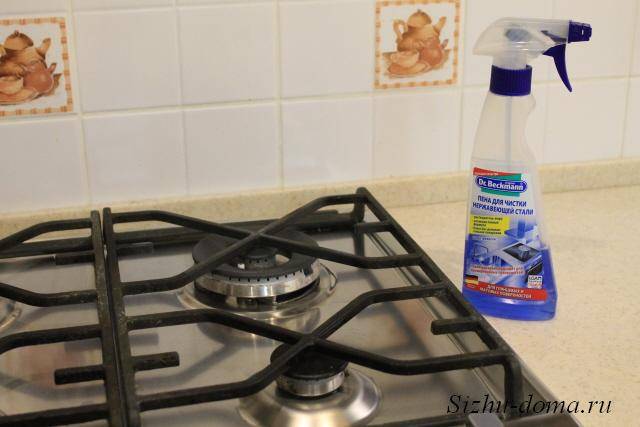
After that, we assemble the stove, reinstalling both the gas heads and the grate.
It took me about twenty minutes to wash the stainless steel plate, even in such a neglected state. At the same time, I was in no hurry, and did not rub the surface of the stove "until I lost my pulse." It was enough just to apply the stainless steel cleaning foam to the stove and then rinse it off!
Yes, with the same product I wash the faucets in the kitchen and bathroom, and other household appliances made of stainless steel.
What tool do you use?
Sometimes it is better to see how it is done once than to read it several times. I suggest watching a video of how a stainless steel gas stove is washed in practice.
In fact, in order to wash the stainless steel stove, it takes only 15 minutes, no more.
Useful information for housewives:
House cleaning, housewife advice
Popular pollution
Let's consider typical examples from life, for many housewives causing, if not panic horror, then strong discontent and irritation, so for sure.
Getting rid of carbon deposits
Note that if you clean your induction hob every day immediately after use, then the likelihood of unpleasant multi-layer deposits is reduced to zero. However, our desires do not always coincide with our own capabilities, so here is a step-by-step instruction for you to eliminate this annoying artifact:
- apply the cleaner to the cloth and place it on the problem area;
- wait 10 minutes - during this time, food residues that spoil the appearance will be safely soaked;
- gently scrape the softened pieces with a scraper;
- remove them with a cloth and wipe dry.

Perfectly helps to wash the induction cooker at home and ordinary sunflower oil. Just apply it on a dirty surface, wait 5-10 minutes, and then clean it with a cloth dampened in warm water.

Or baking soda. Mix it with water to such an extent that you get a paste, and then apply the resulting mass to the desired area. Everything else follows the above algorithm.
We wash off the fat
If conventional glass-ceramic products have not coped with greasy stains, and the surface is not pleasing to the eye, it makes sense to try ammonia.

Surely you have it at home too.
- mix it with water (recommended ratio 1: 5);
- pour the resulting liquid into a container with a spray bottle;
- spray on the surface where grease marks are present;
- let the alcohol produce the desired effect for about 10 minutes;
- wipe with a tissue or sponge.

Eliminate white spots and stains
Another problem associated with the use of induction cookers. Most often appears in cases of salty or sweet water boiling to the surface.

Sometimes even the most effective detergents for glass ceramics cannot cope with such stains.
But this does not mean at all that they do not need to be used: initially, the contaminated area should be treated with just such a gel. It will remove roughness and carbon deposits, but the stain, even if it becomes less noticeable, will still remain.

Never mind: then - here's the most important thing - use a steel cleaner. And do not forget to remove any traces of it with a soft cloth as soon as the whitish streaks and stains have disappeared.
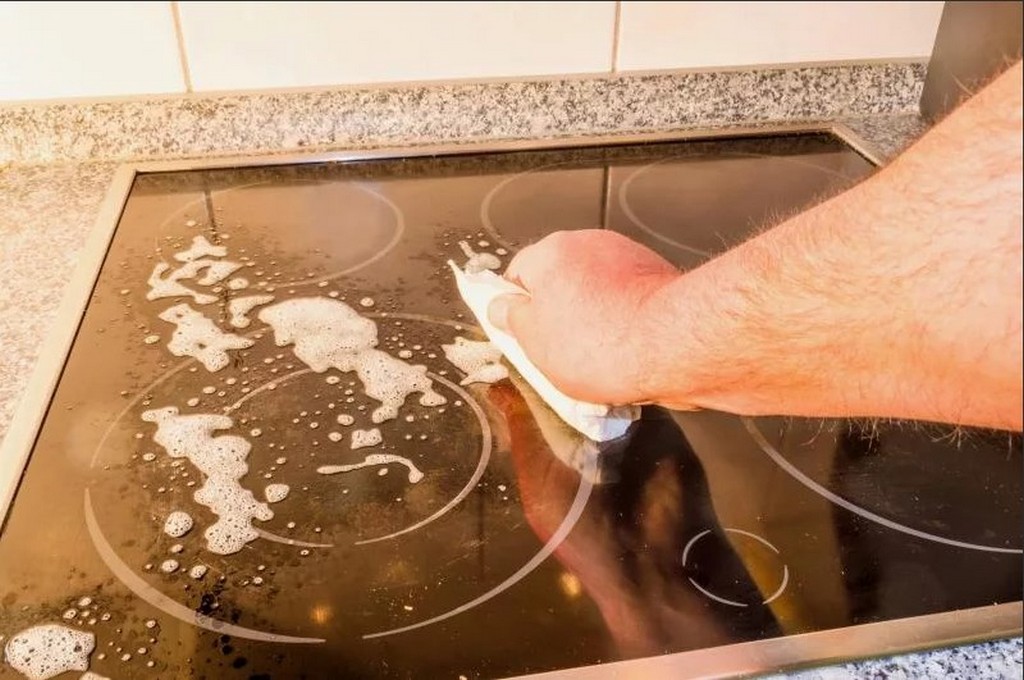
How to clean gas stove grates
First you need to remove coarse dirt (food residues, greasy deposits, carbon deposits). Most of the dirt accumulates in the corners and in the places where the grill meets the stove. The easiest way to remove them is with a scraper (plastic and wood) or a metal brush. But such methods are relevant only for cast iron and steel gratings and are not suitable for enameled ones.

Soda solution
The entire surface of the grill is processed with a sponge, after which it is left for several hours. Further, grease and dirt are removed with a cloth or sponge. In the presence of uncleaned places, a hard sponge or a metal brush should be used to walk over the cast iron or steel grate.
The sponge is moistened with ammonia and the entire grate is processed. To achieve the desired effect and eliminate the unpleasant odor, it is better to put the grill in a plastic bag, leaving it in it for 2-3 hours. Later it is washed with dish detergent and grease and carbon deposits are removed with a sponge.
When using a soap solution, you will need a container of a size and shape suitable for the grid (basin, bucket, sink).The grate has to be soaked for several hours, after which it is washed and cleaned. This method is great for enameled and steel gratings.
The dishwasher for removing dirt will only work on the enamel grill. As for cast iron, a long stay of the material in water is fraught with the appearance of rust.
Car engine cleaner will remove grease and carbon deposits, but you will have to tinker a lot with washing off the remains of the chemical from the surface of the grill.
Ammonia, in turn, is quite effective in getting rid of traces of fat. To do this, a glass of substance is poured onto a baking sheet and placed in an oven preheated to 100 degrees for about half an hour or a little longer. The cooled baking sheet is cleaned with a sponge, detergent and water.


